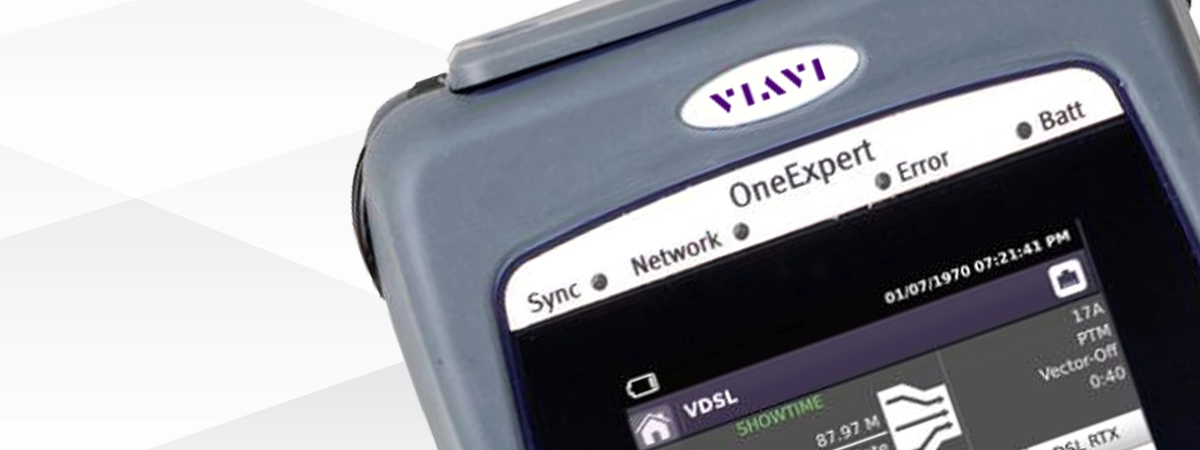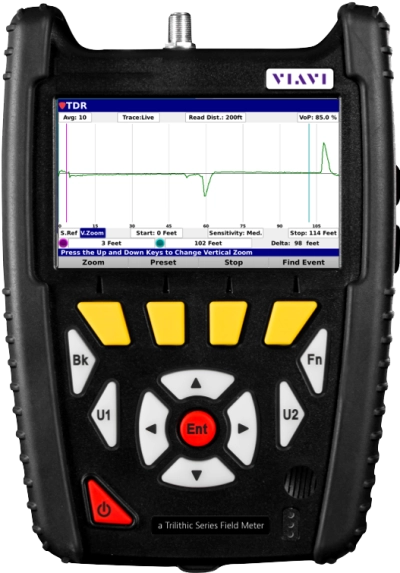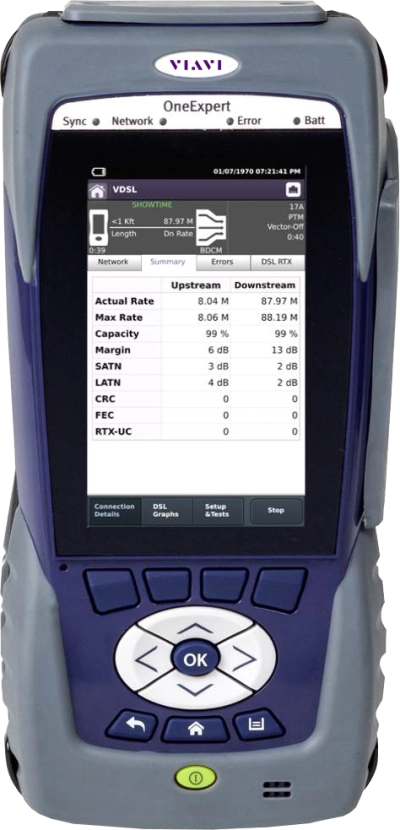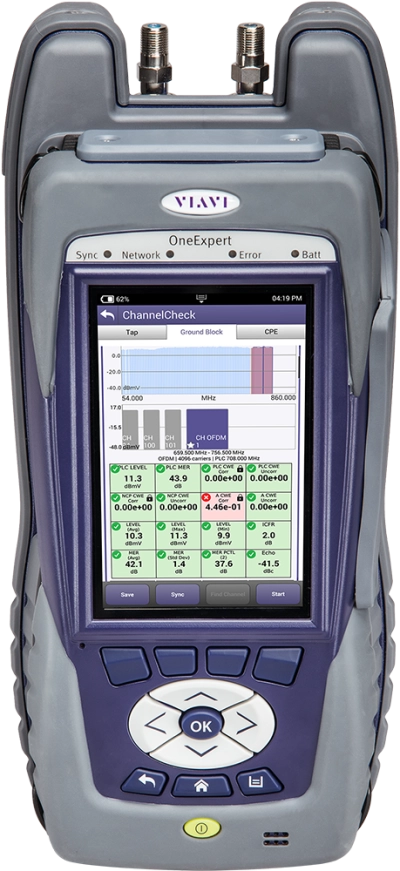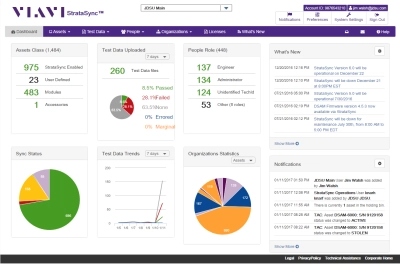Time Domain Reflectometer (TDR)
Try Out Top TDR Test & Measurement Equipment from VIAVI
TDR from VIAVI: Accurate and Portable
Produits
-

DSP TDR (Time Domain Reflectometer)
The DSP TDR precisely locates cable faults or breaks to get service back online as soon as possible.
-

OneExpert DSL (ONX-580)
Offre à chaque fois des résultats haute performance lors du déploiement de services haut débit au domicile des...
-

OneExpert CATV (ONX-620, ONX-630)
L’outil d’analyse des signaux OneExpert CATV permet de vérifier la performance des réseaux et rend le dépannage plus...
-

StrataSync
StrataSync est une solution hébergée sur le cloud permettant de gérer les parcs d'instruments de mesure VIAVI,...
VIAVI has taken TDR technology to the next level. Request a demo for our cutting edge DSP-TDR today and see how our future-proof solutions help you test, maintain, and troubleshoot your network faster and more efficiently than legacy TDRs.
What is a Time Domain Reflectometer (TDR)?
Time domain reflectometers (TDR) are test devices that generate an energy pulse or step on the cable to determine the location and magnitude of cable faults, breaks, splices, terminations, or other events along the length of a conductive cable. Impedance mismatches cause reflections back to the TDR test device where it can be analyzed.
Depending on the timing, phase, and amplitude of the reflected energy, the location and nature of the fault can be precisely determined. Much like optical time domain reflectometry (OTDR) used to characterize fiber optic cable runs, TDR interprets the reflected energy to create a graphical representation of a transmission line or coaxial cable run.
Time Domain Reflectometer Applications
The applications for a TDR include conventional telecommunications use as well as other emerging and diverse functions. As fiber optic links have expanded, new innovations such as DOCSIS have allowed existing coaxial installations to remain viable with the vastly improved speed and bandwidth performance required for modern internet and communication pathways.
Time domain reflectometers can be used to test long cable runs and accurately determine the position of breaks, thus reducing the size and frequency of costly cable repairs (including digging) and minimizing unnecessary span replacements.
Within the telecommunications realm, TDR cable testers are also extremely useful in preventive maintenance applications. Problems such as corrosion, insulation damage, moisture ingress, and other indicators of wear can be proactively detected.
TDR Technology
Since its origin in the 1980s, time domain reflectometry has become an increasingly useful technology as coaxial cable infrastructure has aged and applications for TDR measurement have diversified. The basic operating principles of TDR are analogous to radar because an incident signal is introduced to the cable in order to obtain information from any reflected signals that are observed.
Impedance is the amount of opposition, measured in Ohms (Ω), that material presents to current flow when a voltage is applied. Unlike resistance, impedance results are dependent on the frequency as well as the magnitude of the measurement. Cable faults, changes in cable type, manufacturing defects, and water ingress will all induce location-specific impedance changes that can be reflected back to the TDR test device sampler. The difference between the cable’s characteristic impedance and the reflected impedance can be used to determine the nature and magnitude of the defect.
If the impedance throughout a cable link is uniform, there will be no induced reflections, meaning the continuity and integrity of the line is uninterrupted. If an event is detected, the location can be determined by the TDR cable fault locator by analyzing the reflection cycle time with respect to the velocity of propagation of the cable, which is the nominal speed at which a signal travels through a given conductor material.
The pulse width, typically measured in nanoseconds (ns), is the duration of an induced low voltage signal. A longer pulse width also contains more energy, allowing it to travel further down the cable. A shorter time domain reflectometer pulse width will provide more granular information, particularly for events relatively close to the TDR cable tester. Shorter pulses also minimize the impact of blind spots, which are areas close to a pulse TDR’s step generator where the incident signal and reflected signal overlap leading to invisible defects.
Testing with time domain reflectometers has become more powerful and intuitive as technology and functionality have improved. A TDR test typically begins with a few basic setup functions. The appropriate velocity of propagation must be selected based on the cable type and gage. If legacy TDR technology is used, the range and gain must also be set, based on the expected length of cable under test. This length will typically be displayed on the main view screen as well with preset distance markers along the bottom of the display.
If reflections are detected, their magnitude and position can be determined by moving the cursor to the areas of impedance change on the screen or by utilizing on-screen event lists in more advanced TDR test equipment. Markers can be used to determine the distance between events or the length of a single disturbance. Storage features in a TDR analyzer are useful for comparing a cable trace to a known good (reference) cable or the same cable trace saved from previous measurements.
Pulse TDR
Pulse TDR is the most commonly used time domain reflectometer method. It uses cycles of defined pulse width generation followed by shut-off periods during which the device “listens” for reflected signals. The longer the pulse width, the longer the requisite shut-off period to allow the reflected signal to return. Given this constraint, the pulse width is typically adjustable so that cable length can be considered but shortening the pulse width reduces the resolution at longer distances. A pulse TDR analyzer is subject to large blind spots and inferior resolution based on the relatively low power transmission levels.
Step TDR
The more advanced Step TDR addresses pulse TDR limitations. Step technology allows the TDR measurement equipment to transmit signals continuously while simultaneously monitoring and analyzing the reflected signals. Step TDR operates at a higher transmission power which improves the signal-to-noise ratio. Digital averaging minimizes the impact of any line interference that may compromise the test results and enables higher fault resolution. An additional advantage over pulse TDR is the elimination of blind spots.
Highly portable TDR test equipment with the accuracy and sensitivity once available only in lab-grade instruments provides a cost-effective solution for a wide variety of purposes. With Wi-Fi connectivity and cloud-enabled data management, expectations for TDR analyzer speed, versatility, and simplicity can be continually exceeded.
VIAVI has brought the advanced technology and precision of Step TDR to the rugged, handheld DSP TDR, designed for cable network maintenance workgroups. Despite the advanced technology, the DSP TDR also features a user-friendly interface with an on-screen event list available at the push of a button. This useful feature eliminates the need for a manual event location with the cursor.
A built-in Wi-Fi adapter enables seamless communication with decision-makers. Using the StrataSync cloud-based management solution, data can be conveniently uploaded, analyzed, and retained for future use.
Versatile multi-purpose field testing platforms also include convenient time domain reflectometer functionality for different applications. For local loop testing, the OneExpert DSL combines Wi-Fi, fiber, xDSL, and copper testing capability in one high-performance test solution. For telco workgroups, the OneCheck TDR feature identifies twisted-pair fault types and locations quickly and easily and can be selected through a single button. OneCheck also includes TDR automation features to simplify job documentation and closure.
For cable installation and service, the OneExpert CATV is an additional handheld network performance test platform featuring optional Home TDR capability (tap to home testing) and convenient cloud connectivity via StrataSync. This all-in-one portable test solution can effectively perform DOCSIS 3.1 activation and performance testing, simultaneous ingress, and downstream testing, and optional home leakage testing. With exceptional modularity and automation, the comprehensive feature set also supports WiFi, PON, RFoG, and Ethernet service activation and troubleshooting.
With each new generation of DOCSIS technology raising the bar for speed and bandwidth performance using existing coax links, the future of TDR in the telecommunications realm has been secured. VIAVI product enhancements with Step TDR incorporation and cloud connectivity have vastly improved the overall utility of solutions in the field and created an exceptional long-term value.
With advanced TDR measurement equipment, VIAVI remains committed to cutting edge, future-proof solutions for testing, maintaining, and troubleshooting vital communication pathways.
Suivi à chaque étape
Nous assurons l’assistance, les services, des formations complètes ainsi que les ressources qu’il vous faut. Tout cela dans le but de maximiser la valeur de vos investissements VIAVI.
Interrogez un expert
Contactez-nous pour de plus amples informations ou pour recevoir un devis. Nos experts sont là pour répondre à toutes vos questions.
